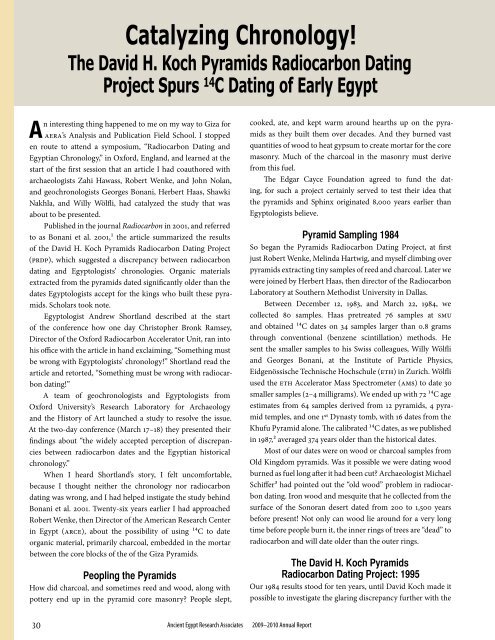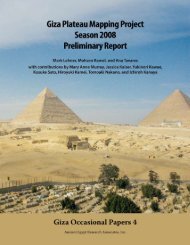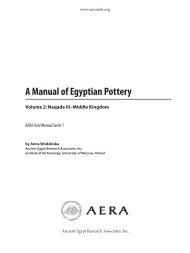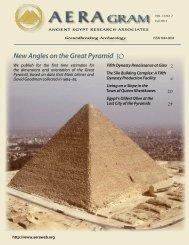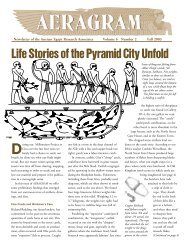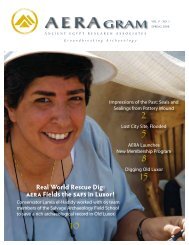Download a PDF of our 2010 Annual Report - Ancient Egypt ...
Download a PDF of our 2010 Annual Report - Ancient Egypt ...
Download a PDF of our 2010 Annual Report - Ancient Egypt ...
You also want an ePaper? Increase the reach of your titles
YUMPU automatically turns print PDFs into web optimized ePapers that Google loves.
A<br />
n interesting thing happened to me on my way to Giza for<br />
AERA’s Analysis and Publication Field School. I stopped<br />
en route to attend a symposium, “Radiocarbon Dating and<br />
<strong>Egypt</strong>ian Chronology,” in Oxford, England, and learned at the<br />
start <strong>of</strong> the first session that an article I had coauthored with<br />
archaeologists Zahi Hawass, Robert Wenke, and John Nolan,<br />
and geochronologists Georges Bonani, Herbert Haas, Shawki<br />
Nakhla, and Willy Wölfli, had catalyzed the study that was<br />
about to be presented.<br />
Published in the j<strong>our</strong>nal Radiocarbon in 2001, and referred<br />
to as Bonani et al. 2001,1 the article summarized the results<br />
<strong>of</strong> the David H. Koch Pyramids Radiocarbon Dating Project<br />
(PRDP), which suggested a discrepancy between radiocarbon<br />
dating and <strong>Egypt</strong>ologists’ chronologies. Organic materials<br />
extracted from the pyramids dated significantly older than the<br />
dates <strong>Egypt</strong>ologists accept for the kings who built these pyramids.<br />
Scholars took note.<br />
<strong>Egypt</strong>ologist Andrew Shortland described at the start<br />
<strong>of</strong> the conference how one day Christopher Bronk Ramsey,<br />
Director <strong>of</strong> the Oxford Radiocarbon Accelerator Unit, ran into<br />
his <strong>of</strong>fice with the article in hand exclaiming, “Something must<br />
be wrong with <strong>Egypt</strong>ologists’ chronology!” Shortland read the<br />
article and retorted, “Something must be wrong with radiocarbon<br />
dating!”<br />
A team <strong>of</strong> geochronologists and <strong>Egypt</strong>ologists from<br />
Oxford University’s Research Laboratory for Archaeology<br />
and the History <strong>of</strong> Art launched a study to resolve the issue.<br />
At the two-day conference (March 17–18) they presented their<br />
findings about “the widely accepted perception <strong>of</strong> discrepancies<br />
between radiocarbon dates and the <strong>Egypt</strong>ian historical<br />
chronology.”<br />
When I heard Shortland’s story, I felt uncomfortable,<br />
because I thought neither the chronology nor radiocarbon<br />
dating was wrong, and I had helped instigate the study behind<br />
Bonani et al. 2001. Twenty-six years earlier I had approached<br />
Robert Wenke, then Director <strong>of</strong> the American Research Center<br />
in <strong>Egypt</strong> (ARCE), about the possibility <strong>of</strong> using 14C to date<br />
organic material, primarily charcoal, embedded in the mortar<br />
between the core blocks <strong>of</strong> the <strong>of</strong> the Giza Pyramids.<br />
Peopling the Pyramids<br />
How did charcoal, and sometimes reed and wood, along with<br />
pottery end up in the pyramid core masonry? People slept,<br />
30<br />
Catalyzing Chronology!<br />
The David H. Koch Pyramids Radiocarbon Dating<br />
Project Spurs 14 C Dating <strong>of</strong> Early <strong>Egypt</strong><br />
<strong>Ancient</strong> <strong>Egypt</strong> Research Associates 2009–<strong>2010</strong> <strong>Annual</strong> <strong>Report</strong><br />
cooked, ate, and kept warm around hearths up on the pyramids<br />
as they built them over decades. And they burned vast<br />
quantities <strong>of</strong> wood to heat gypsum to create mortar for the core<br />
masonry. Much <strong>of</strong> the charcoal in the masonry must derive<br />
from this fuel.<br />
The Edgar Cayce Foundation agreed to fund the dating,<br />
for such a project certainly served to test their idea that<br />
the pyramids and Sphinx originated 8,000 years earlier than<br />
<strong>Egypt</strong>ologists believe.<br />
Pyramid Sampling 1984<br />
So began the Pyramids Radiocarbon Dating Project, at first<br />
just Robert Wenke, Melinda Hartwig, and myself climbing over<br />
pyramids extracting tiny samples <strong>of</strong> reed and charcoal. Later we<br />
were joined by Herbert Haas, then director <strong>of</strong> the Radiocarbon<br />
Laboratory at Southern Methodist University in Dallas.<br />
Between December 12, 1983, and March 22, 1984, we<br />
collected 80 samples. Haas pretreated 76 samples at SMU<br />
and obtained 14C dates on 34 samples larger than 0.8 grams<br />
through conventional (benzene scintillation) methods. He<br />
sent the smaller samples to his Swiss colleagues, Willy Wölfli<br />
and Georges Bonani, at the Institute <strong>of</strong> Particle Physics,<br />
Eidgenössische Technische Hochschule (ETH) in Zurich. Wölfli<br />
used the ETH Accelerator Mass Spectrometer (AMS) to date 30<br />
smaller samples (2–4 milligrams). We ended up with 72 14C age<br />
estimates from 64 samples derived from 12 pyramids, 4 pyramid<br />
temples, and one 1st Dynasty tomb, with 16 dates from the<br />
Khufu Pyramid alone. The calibrated 14C dates, as we published<br />
in 1987,2 averaged 374 years older than the historical dates.<br />
Most <strong>of</strong> <strong>our</strong> dates were on wood or charcoal samples from<br />
Old Kingdom pyramids. Was it possible we were dating wood<br />
burned as fuel long after it had been cut? Archaeologist Michael<br />
Schiffer3 had pointed out the “old wood” problem in radiocarbon<br />
dating. Iron wood and mesquite that he collected from the<br />
surface <strong>of</strong> the Sonoran desert dated from 200 to 1,500 years<br />
before present! Not only can wood lie around for a very long<br />
time before people burn it, the inner rings <strong>of</strong> trees are “dead” to<br />
radiocarbon and will date older than the outer rings.<br />
The David H. Koch Pyramids<br />
Radiocarbon Dating Project: 1995<br />
Our 1984 results stood for ten years, until David Koch made it<br />
possible to investigate the glaring discrepancy further with the


